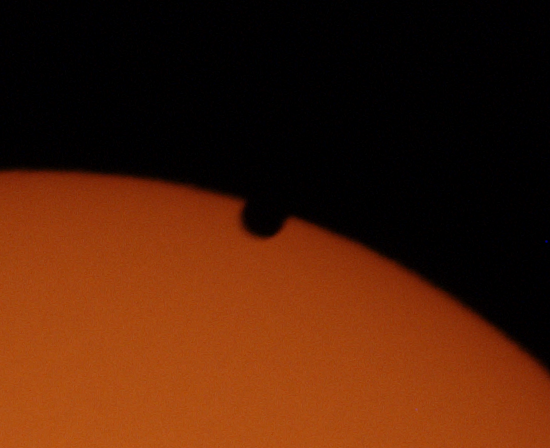For starters, here is an image of the moon before the partial eclipse starts. It is already in the penumbral phase, so there is a little bit of fading on the lower left edge. That is where the umbra will contact the moon when it gets there. I also need to point out here the glow all around the image of the moon. That is from the weather that day. It was a humid night with high, thin clouds. It is the moonlight on the high clouds that is causing that glow around the moon. That's too bad. Many of the images were completely washed out as thicker clouds passed in front of the image. There is nothing to be done, it's the conditions and we have to live with it. Keep this in mind with all the images that follow.
 Now the eclipse is starting. That bite on the bottom left is the shadow cast by the planet Earth. The moon is moving down and to the left into the shadow and it will take about an hour to completely enter the shadow. The moon, in its orbit around the Earth, moves noticeably through the night sky, and my rule of thumb is that it moves about one moon diameter in one hour.
Now the eclipse is starting. That bite on the bottom left is the shadow cast by the planet Earth. The moon is moving down and to the left into the shadow and it will take about an hour to completely enter the shadow. The moon, in its orbit around the Earth, moves noticeably through the night sky, and my rule of thumb is that it moves about one moon diameter in one hour.Look carefully the shape of that shadow. Note that it is curved and fuzzy. The curve is the curvature of the Earth (It's round!) and the fuzz is the distortion of the edge of the shadow by our atmosphere. There is probably a bit of that glowing humidity in there too:-(
Further into the partial eclipse, and it's looking pretty good. The weather is improving so the image it noticeably sharper. Note that the curve of the Earth's shadow is pretty gradual. That's significant. Imagine what this means to someone standing on the surface of the moon. It is pretty clear from this that the Earth in that person's sky will look much bigger than the sun. It would clearly dominate the sky.
Also, while we're thinking about such things, you'll be noticing that the Earth will always be stationary in the moon-person's sky, so this eclipse will appear like the sun is moving behind the Earth. The dark, night time, Earth. Kool!
Now we're getting somewhere! I adjusted the position of the camera here, so now the Earth's shadow is on the upper left. The eclipse is almost total, but there is just a tiny bit of lit Moon on the right side.
The whole image looks pretty dark, there is not much light coming back from the moon. (Also, those pesky clouds, although they're not too bad in this image.) You can start to see a gradient of color from the white that is lit, through to the orange. This gradient is in the other images as well, but the red is so much fainter that we can't really see it. In fact, the exposure is much longer for this image than that for the previous images. (2sec shutter, ISO1600). Looking without the telescope is giving a similar experience, as one's eyes start to night adapt.
And this is the main event. This is as close to totality as we were able to get. Shortly after this, the clouds got so thick that we couldn't see it anymore.
The moon didn't pass through the center of the Earth's shadow, but instead passed through the bottom half. So given the shadow is fuzzy, there is some bit of lighting on the bottom edge, so we get this rainbow of color, from blue-white through orange to deep red. It probably got deeper red over time, but the weather was not kind.
You may notice that this image is not as bright (read: saturated) as many other images you will see on the 'net. It is common to brighten images of lunar eclipses to bring out the color, but the images I'm posting here are close to how I actually experienced them. I like doing it this way.












